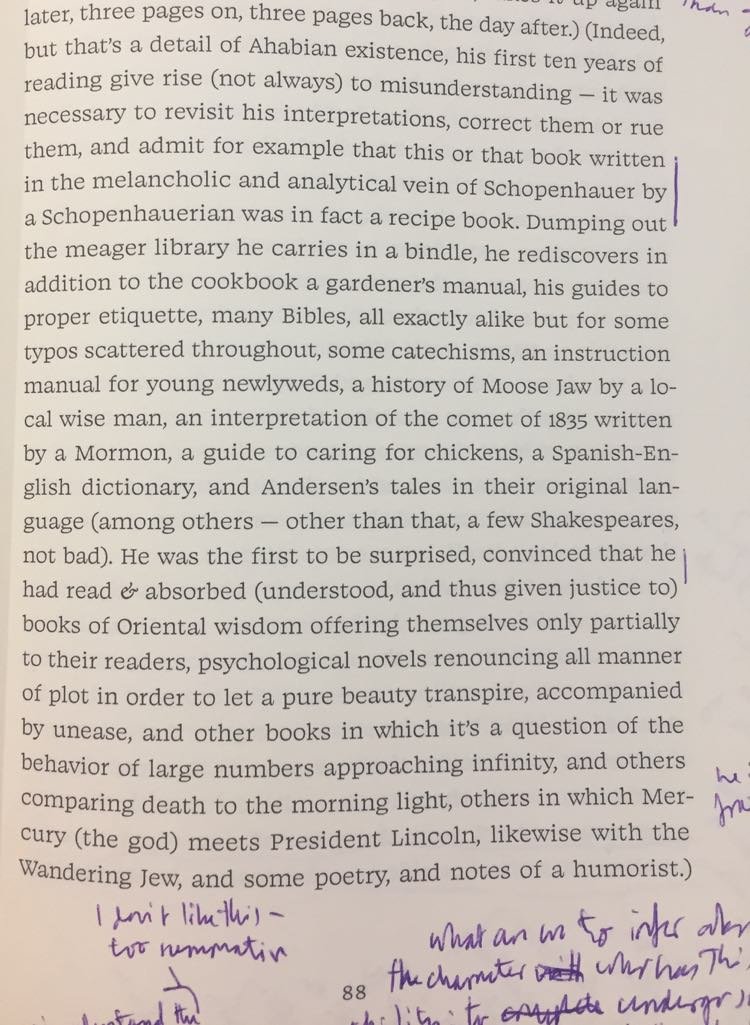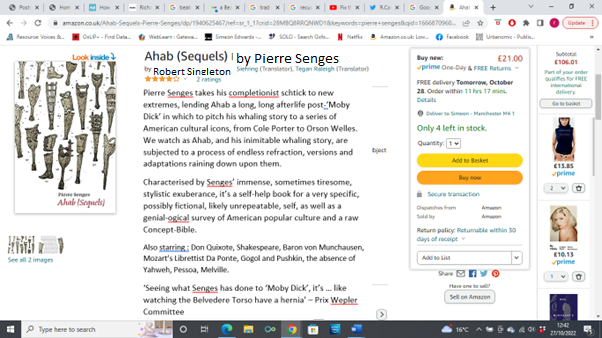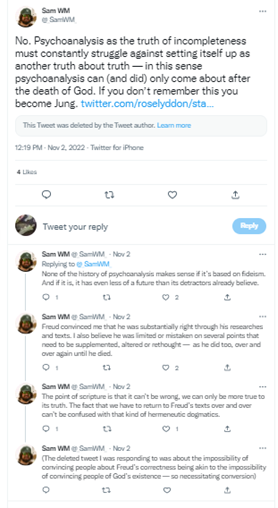Pierre Senges, 'Ahab (Sequels)' (2015)
Ahab the Reader
No-one has ever read like Ahab reads in ‘Ahab (Sequels).’
He removes almost all passivity from the act of reading. He sees himself as completely responsible for what he reads, he instrumentalises books ferociously, all that they contain, top to bottom (you could say, he plays books like instruments, grabbing them and holding them weirdly and squeezing them to extract his own personal kinds of kernels and goodies from out of them).
He finds his own books to read in the pages of completely unrelated books, his own King Lear in the pages of a cookery book, >
we are told
- ‘indulgence for him being at this precise moment the least bad way of reading’
- ‘theory should feed pleasure’
- ‘it is up to us now to have projects of inventive revenge, to mix in memories and apprehensions, and misunderstandings borne of hasty reading’
What is a book to the reader who holds themselves completely responsible for what they read within it? We still can’t say. Barthes has tried to imagine, and to illustrate, what Balzac’s ‘Sarrasine’ would look like to the reader who held themselves responsible for 15% of what they read in it. Singleton, I dare say, tries to present a picture of the text whose reader holds themselves responsible for around 25% of what they read in it. But Ahab in ‘Ahab (Sequels)’ sends the project into overdrive … he is surely operating at around 85% ! …
Exhibit A : pg 88

Exhibit B : pg 446. This is what a book looks like in ‘Ahab (Sequels)’: ‘Splitting up his copy of the Quixote, scattering its pages from one country to another and simultaneously cutting, reattaching, losing pieces of his own Quixote, to the point that more often he gets the impression that he’s repairing it.’
‘ ‘Ahab (Sequels)’ by Pierre Senges’ by Robert Singleton
The novel is 36 pages long. It is split into 11 Chapters, and 3 Appendixes.
Chapters
2 – ‘Ahab on dry land – visit to right angles’
3 – The Deflation of Ahab
4 – Ahab the Reader (Singleton in the wild)
5 – The Kernel of Ruby’s Interpretation (‘Ahab (Sequels)’ and the commercialisation of the avante-garde) https://www.thenation.com/article/culture/pierre-senges-ahab-sequels/
6 – Mass Demand for the Highly Specific, or, Ahab muses on the success of Broadway
7 – ‘Interlude – concerning the dramaturgy of the self (to escape depression)’
8 – Ahab dances on deck to re-infuse the Ocean with meaning, replacing contingency with absurdity
9 – The Remains of Orson Welles
10 – On Absurdity
11 – Ahab reads ‘Moby Dick’ : the derived character astute enough not to identify with the materials, the constitutive elements, from which they were derived

Dustin Illingworth – ‘Notes towards a review’
Together the 3 Appendixes can be compared to an instruction manual for a game.
Appendix 1 describes or introduces the setting. Appendix 2 lays out the forms of movement available within this setting. Appendix 3 describes the form and structure taken by players in the game, the abilities they have.
Appendix 1 – Quantity Universe.
‘ ‘Ahab (Sequels)’ by Pierre Senges’ by Robert Singleton takes place in a universe of (recusant?) amounts. Quantities aren’t given and refuse to be estimated or approximated. If an amount is too large to be reached by a feasible counting effort then it has to be reached by some other exertion of thought, some other, improvised, form of mental accrual. In a quantity universe there is no workable substitute for specificity. In a quantity universe totting is a constant necessity. ’12 million’ can’t just be stated, it has to be elaborately totted. And no accumulation is permanent, amounts can be achieved, then lost, then regained by other means.
Appendix 2 – Navigation
To navigate in an unstable medium, like an ocean, or a quantity universe, one must put in place certain preconditions, make arrangements to turn the medium into a plane. In an unstable medium the only way of moving is the establishment of a true north, a universal reference point, a flattener, an equaliser, then everything can fall into place, like the ability to differentiate between chasing and fleeing, arriving and departing etc. First one must decide on a goal, then it’s about sitting back, and watching as the wholesale transformation of worldly phenomena into a menagerie of compass points, sat-navs, proximity-measuring dials and detection devices takes place before you, watching the numerous things of the world sprout forth little sets of arms with which to hold aloft big arrows and point you on your way. Navigation requires resource mining, a method for exposing, getting at, the instrumentalize-able kernel in each and all things.
Appendix 3 – Derived, Allusive
At a cursory glance one may think that the players look a bit like the Pompidou centre. A system of tubes and pipes with a person somewhere inside. Like an exposed respiratory system but for narratives, types of self-image, tonal registers – all borrowed, hoovered up. Constant barter between versions of an action or stance or event, the versions are listed out, like mood-boards, reference points, for that particular action, then selected through a process of bartering. Players are engaged in a constant activity of conversion and exchange, choosing what narratives to run through the overlaying tubes, hooking themselves up to the imaginative resources, the imaginative capital or stock, contained in the world’s parts and feeding it through the system of tubes winding around their selves. Making the most of being porous; making allusions, choosing between allusions, constantly.
Jack Kerouac read ‘ ‘Ahab (Sequels)’ by Pierre Senges’ by Robert Singleton. Carried it out on hikes in his satchel bag, and read it in the bedroom of his house in San Francisco, a bedroom he set up on the ground-floor. He liked to pretend it was part of the corpus of Zen Buddhist teachings he was also engaged in reading at that time, or sometimes that it was even older. ‘A proper wisdom tome’ he called it. Friends would remark on it when they saw it on the kitchen table and he’d say ‘yeahh – that Senges – he throws down some real configurations … Big sentences’, sometimes he’d gesture with his hands when he said ‘Big.’ He thought there were practises to be extricated from it and came up with a few new breathing exercises that same year.


The Missing Chapter
There is a missing chapter in ‘‘Ahab (Sequels)’ by Pierre Senges’ by Robert Singleton, the one Singleton lost and can’t read back into its place, he’s misplaced his reading, forgotten it somewhere, (irresponsible!), he hasn’t got his 35% to put back in place, but only clues about what it was. And a thesis.
(And a desire to write in the character of a weird L’Ecole Normale Superieure student – a student who spent their time at the university theorizing about their lecturers, diagramming them, imagining the faculty gossip, instead of going to their lectures).
‘Rereading is tantamount to denigrating, or even depriving it of its substance : by dint of being reconsidered every five minutes, the dazzling story, otherwise referred to as a stroke of genius, becomes a dull, routine little joke – and the most trying thing isn’t noticing the dreary routine, but knowing intimately that one is the author.’ (pg437) Even drearier and more testing is losing the routine, trying to re-build it on top of an uncooperative page, losing one’s authorship, remembering that it had been quite charming at the time, that 35% … Trying to get it going again with whatever materials, clues, one can get hold of, probably the wrong ones.
(But taking the opportunity to add some new ones. A dream, why not?)
Clue 1 : The Missing Chapter contains Cities (Proiretic Code)
The missing chapter is about the use of cities, as traps, as strategies, as hide and seek games, as imprints left by the absence of God, and how we lead ourselves around them in search of the idea we have about them – ‘New York’ and what we hope to make of it pulls us on a lead through a set of naked streets and intersections on the East Coast.
The tube-self is so like those naked streets! ‘God’ was once the main system of pulleys yanking people up and down their tubes. But now the pulleys are unmanned, hanging limply like the bell-ropes in abandoned churches.

-bartering, inflating, deflating, totting, converting, accruing, navigating, plotting, getting yanked every which way- (Verb List from ‘‘Ahab (Sequels)’ by Pierre Senges’ by Robert Singleton). But all these activities are played on an emaciated board: Ahab’s porous self. Try to think and navigate that Eastern seaboard city without the idea ‘New York’ to help you, and you would find yourself a player on the emaciated board, a lonely inhabitant of the porous self – this is the fact of incompleteness, and there’s a tradition of thinkers who would tell us that it is the only ‘human fact.’

Clue 2 : The Missing Chapter contains Psychoanalysis (Cultural Code)
Singleton’s ‘Senges’ attended a few of Jacques Lacan’s seminars. In his lecture notes he wrote ‘Unconsciousness is the language in which the fact of the subject’s incompleteness is revealed (a language of malfunctions).’ From Lacan he learnt how a subject can attend to the internal logic of their own malfunctions by thinking of them as a language, but Singleton’s ‘Senges’ believed that the point of a language is being able to cleave to it, to wield it, and that there is little point in discovering a language which can only be attended to. So Singleton’s ‘Senges’ began to imagine a neurotic character with the miraculous ability to overthink themselves out of overthinking, a character whose unconscious wasn’t just structured like a language but structured like a particular example of language use (split into 135 Chapters and titled ‘Moby Dick’) –
A character pushed out the back-end of some unfathomable, and most likely torturous, process of identification which has left it, somehow, with a 19th century novel as its unconsciousness, a character who has planted incompleteness within the heart of this novel by planting themselves there, like a de-completing parasite, an acid, identifying the novel as unfinished and itself as an unlikely and unfolding ‘sequel’ to it (are we not all sequels to the unacknowledged catastrophes upon which our unconsciousness’s are founded?), seeking to ameliorate this incompleteness through a sustained and drastic course of lived literary revisionism.
Singleton’s ‘Senges’ developed his own school of Psychoanalytic thought, devoted entirely to the analysis of this one case-study.
Clue 3 : The Missing Chapter contains
‘our lives plug little holes in the hole-universe of another’s mind’ – something unpredictable is registered here, a shift in implication. Novels can have unprecedented moments, sometimes things happen in a novel which have no precedent in the novel; you get accustomed to thinking it (the novel) is looking in some other direction and then suddenly it’s looking right at you.
Something to do with Ahab experiencing [being put through] universalization, mythologization – the forces he articulates (incompleteness, quantity, exchange, allusion and debt) being meted out equally, generously meted out across the globe, a glimpse of the reality this would create.
A glimpse of the reality this would create. All novels have metaphysical leanings, offer up some world-ordering forces, some alternatives to Gravity, rivals to Hell – novelistic masterbuilding, bourgeois cosmogenesis – there are moments, never admitted, at which a George Eliot fancies themselves, in their text, quite Moses, unloading pure Metaphysic, drawing up pure Legislation, in their description of some rural town’s Thursday morning. All it amounts to on the page, all the novelist can do with the tools at their disposal, are slight gestures towards universalization, a ‘visionary sheen’, which set a character slightly off balance so for a moment it could be confused for a character in a Joyce-novel (Joyceanization is something that can suddenly happen to characters like [oxidation can happen to metals]), a slight warping, but it’s enough for the novel’s bottom to fall out, suddenly it’s hanging over infinite space, vertigo-inducing as the reader looks down through it over its edge.